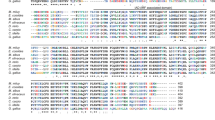Abstract
Using an oligonucleotide primer based on a partial goldfish inducible nitric oxide synthase (iNOS) sequence, a complete carp iNOS cDNA was isolated from an activated carp phagocyte cDNA library. Nucleotide and predicted amino acid sequence analysis indicate that carp iNOS encodes a 1127-amino acid protein with 57% sequence identity to human iNOS. Like mammalian NOSs, carp iNOS protein contains putative binding sites for heme, tetrahydrobiopterin, calmodulin, flavine mononucleotide, flavine adenine dinucleotide, and NADPH. Phylogenetic analysis, using neighbor joining, showed that the carp iNOS protein clustered together with the other vertebrate iNOS proteins. Inducibility of carp iNOS was confirmed by reverse transcription-polymerase chain reaction after stimulation of carp phagocytes with lipopolysaccharide or the protozoan blood flagellate Trypanoplasma borreli. These stimulators produced high amounts of nitric oxide that were toxic for T. borreli in vitro. The nuclear transciption factor NF-κB was shown to play a role in the induction of iNOS transcription.
Similar content being viewed by others
Author information
Authors and Affiliations
Additional information
Received: 14 October 1999 / Revised: 8 November 1999
Rights and permissions
About this article
Cite this article
Saeij, J., Stet, R., Groeneveld, A. et al. Molecular and functional characterization of a fish inducible-type nitric oxide synthase. Immunogenetics 51, 339–346 (2000). https://doi.org/10.1007/s002510050628
Issue Date:
DOI: https://doi.org/10.1007/s002510050628




